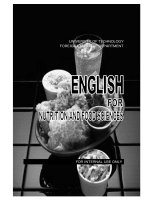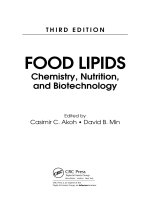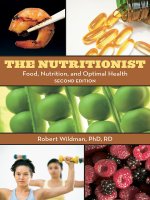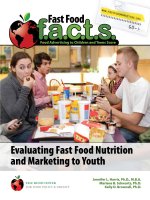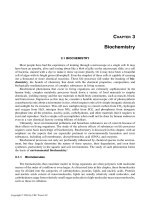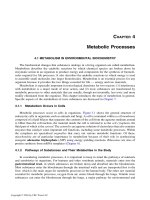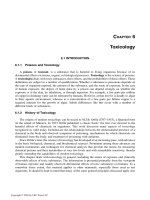Food lipids chemistry, nutrition, and biochemistry
Bạn đang xem bản rút gọn của tài liệu. Xem và tải ngay bản đầy đủ của tài liệu tại đây (5.63 MB, 1,015 trang )
TM
Marcel Dekker, Inc. New York
•
Basel
Food Lipids
Chemistry, Nutrition, and Biotechnology
Second Edition, Revised and Expanded
edited by
Casimir C. Akoh
The Univeristy of Georgia
Athens, Georgia
David B. Min
The Ohio State University
Columbus, Ohio
Copyright © 2002 by Marcel Dekker, Inc. All Rights Reserved.
ISBN: 0-8247-0749-4
This book is printed on acid-free paper.
Headquarters
Marcel Dekker, Inc.
270 Madison Avenue, New York, NY 10016
tel: 212-696-9000; fax: 212-685-4540
Eastern Hemisphere Distribution
Marcel Dekker AG
Hutgasse 4, Postfach 812, CH-4001 Basel, Switzerland
tel: 41-61-261-8482; fax: 41-61-261-8896
World Wide Web
The publisher offers discounts on this book when ordered in bulk quantities. For more information,
write to Special Sales/Professional Marketing at the headquarters address above.
Copyright ᭧ 2002 by Marcel Dekker, Inc. All Rights Reserved.
Neither this book nor any part may be reproduced or transmitted in any form or by any means,
electronic or mechanical, including photocopying, microfilming, and recording, or by any infor-
mation storage and retrieval system, without permission in writing from the publisher.
Current printing (last digit):
10987654321
PRINTED IN THE UNITED STATES OF AMERICA
FOOD SCIENCE AND TECHNOLOGY
A Series of Monographs, Textbooks, and Reference Books
EDITORIAL BOARD
Senior Editors
Owen R. Fennema University of Wisconsin–Madison
Y.H. Hui Science Technology System
Marcus Karel Rutgers University (emeritus)
Pieter Walstra Wageningen University
John R. Whitaker University of California–Davis
Additives P. Michael Davidson University of Tennessee–Knoxville
Dairy science James L. Steele University of Wisconsin–Madison
Flavor chemistry and sensory analysis John H. Thorngate III University
of California–Davis
Food engineering Daryl B. Lund University of Wisconsin–Madison
Food proteins/food chemistry Rickey Y. Yada University of Guelph
Health and disease Seppo Salminen University of Turku, Finland
Nutrition and nutraceuticals Mark Dreher Mead Johnson Nutritionals
Phase transition/food microstructure Richard W. Hartel University of
Wisconsin–Madison
Processing and preservation Gustavo V. Barbosa-Cánovas Washington
State University–Pullman
Safety and toxicology Sanford Miller University of Texas–Austin
1. Flavor Research: Principles and Techniques, R. Teranishi, I. Horn-
stein, P. Issenberg, and E. L. Wick
2. Principles of Enzymology for the Food Sciences, John R. Whitaker
3. Low-Temperature Preservation of Foods and Living Matter, Owen R.
Fennema, William D. Powrie, and Elmer H. Marth
4. Principles of Food Science
Part I: Food Chemistry, edited by Owen R. Fennema
Part II: Physical Methods of Food Preservation, Marcus Karel, Owen
R. Fennema, and Daryl B. Lund
5. Food Emulsions, edited by Stig E. Friberg
6. Nutritional and Safety Aspects of Food Processing, edited by Steven
R. Tannenbaum
7. Flavor Research: Recent Advances, edited by R. Teranishi, Robert A.
Flath, and Hiroshi Sugisawa
8. Computer-Aided Techniques in Food Technology, edited by Israel
Saguy
9. Handbook of Tropical Foods, edited by Harvey T. Chan
10. Antimicrobials in Foods, edited by Alfred Larry Branen and P. Michael
Davidson
11. Food Constituents and Food Residues: Their Chromatographic
Determination, edited by James F. Lawrence
12. Aspartame: Physiology and Biochemistry, edited by Lewis D. Stegink
and L. J. Filer, Jr.
13. Handbook of Vitamins: Nutritional, Biochemical, and Clinical Aspects,
edited by Lawrence J. Machlin
14. Starch Conversion Technology, edited by G. M. A. van Beynum and J.
A. Roels
15. Food Chemistry: Second Edition, Revised and Expanded, edited by
Owen R. Fennema
16. Sensory Evaluation of Food: Statistical Methods and Procedures, Mi-
chael O'Mahony
17. Alternative Sweeteners, edited by Lyn O'Brien Nabors and Robert C.
Gelardi
18. Citrus Fruits and Their Products: Analysis and Technology, S. V. Ting
and Russell L. Rouseff
19. Engineering Properties of Foods, edited by M. A. Rao and S. S. H.
Rizvi
20. Umami: A Basic Taste, edited by Yojiro Kawamura and Morley R.
Kare
21. Food Biotechnology, edited by Dietrich Knorr
22. Food Texture: Instrumental and Sensory Measurement, edited by
Howard R. Moskowitz
23. Seafoods and Fish Oils in Human Health and Disease, John E.
Kinsella
24. Postharvest Physiology of Vegetables, edited by J. Weichmann
25. Handbook of Dietary Fiber: An Applied Approach, Mark L. Dreher
26. Food Toxicology, Parts A and B, Jose M. Concon
27. Modern Carbohydrate Chemistry, Roger W. Binkley
28. Trace Minerals in Foods, edited by Kenneth T. Smith
29. Protein Quality and the Effects of Processing, edited by R. Dixon
Phillips and John W. Finley
30. Adulteration of Fruit Juice Beverages, edited by Steven Nagy, John A.
Attaway, and Martha E. Rhodes
31. Foodborne Bacterial Pathogens, edited by Michael P. Doyle
32. Legumes: Chemistry, Technology, and Human Nutrition, edited by
Ruth H. Matthews
33. Industrialization of Indigenous Fermented Foods, edited by Keith H.
Steinkraus
34. International Food Regulation Handbook: Policy · Science · Law,
edited by Roger D. Middlekauff and Philippe Shubik
35. Food Additives, edited by A. Larry Branen, P. Michael Davidson, and
Seppo Salminen
36. Safety of Irradiated Foods, J. F. Diehl
37. Omega-3 Fatty Acids in Health and Disease, edited by Robert S. Lees
and Marcus Karel
38. Food Emulsions: Second Edition, Revised and Expanded, edited by
Kåre Larsson and Stig E. Friberg
39. Seafood: Effects of Technology on Nutrition, George M. Pigott and
Barbee W. Tucker
40. Handbook of Vitamins: Second Edition, Revised and Expanded,
edited by Lawrence J. Machlin
41. Handbook of Cereal Science and Technology, Klaus J. Lorenz and
Karel Kulp
42. Food Processing Operations and Scale-Up, Kenneth J. Valentas,
Leon Levine, and J. Peter Clark
43. Fish Quality Control by Computer Vision, edited by L. F. Pau and R.
Olafsson
44. Volatile Compounds in Foods and Beverages, edited by Henk Maarse
45. Instrumental Methods for Quality Assurance in Foods, edited by
Daniel Y. C. Fung and Richard F. Matthews
46. Listeria, Listeriosis, and Food Safety, Elliot T. Ryser and Elmer H.
Marth
47. Acesulfame-K, edited by D. G. Mayer and F. H. Kemper
48. Alternative Sweeteners: Second Edition, Revised and Expanded, ed-
ited by Lyn O'Brien Nabors and Robert C. Gelardi
49. Food Extrusion Science and Technology, edited by Jozef L. Kokini,
Chi-Tang Ho, and Mukund V. Karwe
50. Surimi Technology, edited by Tyre C. Lanier and Chong M. Lee
51. Handbook of Food Engineering, edited by Dennis R. Heldman and
Daryl B. Lund
52. Food Analysis by HPLC, edited by Leo M. L. Nollet
53. Fatty Acids in Foods and Their Health Implications, edited by Ching
Kuang Chow
54. Clostridium botulinum: Ecology and Control in Foods, edited by
Andreas H. W. Hauschild and Karen L. Dodds
55. Cereals in Breadmaking: A Molecular Colloidal Approach,
Ann-Charlotte Eliasson and Kåre Larsson
56. Low-Calorie Foods Handbook, edited by Aaron M. Altschul
57. Antimicrobials in Foods: Second Edition, Revised and Expanded,
edited by P. Michael Davidson and Alfred Larry Branen
58. Lactic Acid Bacteria, edited by Seppo Salminen and Atte von Wright
59. Rice Science and Technology, edited by Wayne E. Marshall and
James I. Wadsworth
60. Food Biosensor Analysis, edited by Gabriele Wagner and George G.
Guilbault
61. Principles of Enzymology for the Food Sciences: Second Edition, John
R. Whitaker
62. Carbohydrate Polyesters as Fat Substitutes, edited by Casimir C.
Akoh and Barry G. Swanson
63. Engineering Properties of Foods: Second Edition, Revised and
Expanded, edited by M. A. Rao and S. S. H. Rizvi
64. Handbook of Brewing, edited by William A. Hardwick
65. Analyzing Food for Nutrition Labeling and Hazardous Contaminants,
edited by Ike J. Jeon and William G. Ikins
66. Ingredient Interactions: Effects on Food Quality, edited by Anilkumar
G. Gaonkar
67. Food Polysaccharides and Their Applications, edited by Alistair M.
Stephen
68. Safety of Irradiated Foods: Second Edition, Revised and Expanded, J.
F. Diehl
69. Nutrition Labeling Handbook, edited by Ralph Shapiro
70. Handbook of Fruit Science and Technology: Production, Composition,
Storage, and Processing, edited by D. K. Salunkhe and S. S. Kadam
71. Food Antioxidants: Technological, Toxicological, and Health Perspec-
tives, edited by D. L. Madhavi, S. S. Deshpande, and D. K. Salunkhe
72. Freezing Effects on Food Quality, edited by Lester E. Jeremiah
73. Handbook of Indigenous Fermented Foods: Second Edition, Revised
and Expanded, edited by Keith H. Steinkraus
74. Carbohydrates in Food, edited by Ann-Charlotte Eliasson
75. Baked Goods Freshness: Technology, Evaluation, and Inhibition of
Staling, edited by Ronald E. Hebeda and Henry F. Zobel
76. Food Chemistry: Third Edition, edited by Owen R. Fennema
77. Handbook of Food Analysis: Volumes 1 and 2, edited by Leo M. L.
Nollet
78. Computerized Control Systems in the Food Industry, edited by Gauri
S. Mittal
79. Techniques for Analyzing Food Aroma, edited by Ray Marsili
80. Food Proteins and Their Applications, edited by Srinivasan Damo-
daran and Alain Paraf
81. Food Emulsions: Third Edition, Revised and Expanded, edited by Stig
E. Friberg and Kåre Larsson
82. Nonthermal Preservation of Foods, Gustavo V. Barbosa-Cánovas,
Usha R. Pothakamury, Enrique Palou, and Barry G. Swanson
83. Milk and Dairy Product Technology, Edgar Spreer
84. Applied Dairy Microbiology, edited by Elmer H. Marth and James L.
Steele
85. Lactic Acid Bacteria: Microbiology and Functional Aspects: Second
Edition, Revised and Expanded, edited by Seppo Salminen and Atte
von Wright
86. Handbook of Vegetable Science and Technology: Production,
Composition, Storage, and Processing, edited by D. K. Salunkhe and
S. S. Kadam
87. Polysaccharide Association Structures in Food, edited by Reginald H.
Walter
88. Food Lipids: Chemistry, Nutrition, and Biotechnology, edited by
Casimir C. Akoh and David B. Min
89. Spice Science and Technology, Kenji Hirasa and Mitsuo Takemasa
90. Dairy Technology: Principles of Milk Properties and Processes, P.
Walstra, T. J. Geurts, A. Noomen, A. Jellema, and M. A. J. S. van
Boekel
91. Coloring of Food, Drugs, and Cosmetics, Gisbert Otterstätter
92. Listeria, Listeriosis, and Food Safety: Second Edition, Revised and
Expanded, edited by Elliot T. Ryser and Elmer H. Marth
93. Complex Carbohydrates in Foods, edited by Susan Sungsoo Cho,
Leon Prosky, and Mark Dreher
94. Handbook of Food Preservation, edited by M. Shafiur Rahman
95. International Food Safety Handbook: Science, International Regula-
tion, and Control, edited by Kees van der Heijden, Maged Younes,
Lawrence Fishbein, and Sanford Miller
96. Fatty Acids in Foods and Their Health Implications: Second Edition,
Revised and Expanded, edited by Ching Kuang Chow
97. Seafood Enzymes: Utilization and Influence on Postharvest Seafood
Quality, edited by Norman F. Haard and Benjamin K. Simpson
98. Safe Handling of Foods, edited by Jeffrey M. Farber and Ewen C. D.
Todd
99. Handbook of Cereal Science and Technology: Second Edition, Re-
vised and Expanded, edited by Karel Kulp and Joseph G. Ponte, Jr.
100. Food Analysis by HPLC: Second Edition, Revised and Expanded,
edited by Leo M. L. Nollet
101. Surimi and Surimi Seafood, edited by Jae W. Park
102. Drug Residues in Foods: Pharmacology, Food Safety, and Analysis,
Nickos A. Botsoglou and Dimitrios J. Fletouris
103. Seafood and Freshwater Toxins: Pharmacology, Physiology, and
Detection, edited by Luis M. Botana
104. Handbook of Nutrition and Diet, Babasaheb B. Desai
105. Nondestructive Food Evaluation: Techniques to Analyze Properties
and Quality, edited by Sundaram Gunasekaran
106. Green Tea: Health Benefits and Applications, Yukihiko Hara
107. Food Processing Operations Modeling: Design and Analysis, edited
by Joseph Irudayaraj
108. Wine Microbiology: Science and Technology, Claudio Delfini and
Joseph V. Formica
109. Handbook of Microwave Technology for Food Applications, edited by
Ashim K. Datta and Ramaswamy C. Anantheswaran
110. Applied Dairy Microbiology: Second Edition, Revised and Expanded,
edited by Elmer H. Marth and James L. Steele
111. Transport Properties of Foods, George D. Saravacos and Zacharias
B. Maroulis
112. Alternative Sweeteners: Third Edition, Revised and Expanded, edited
by Lyn O’Brien Nabors
113. Handbook of Dietary Fiber, edited by Susan Sungsoo Cho and Mark
L. Dreher
114. Control of Foodborne Microorganisms, edited by Vijay K. Juneja and
John N. Sofos
115. Flavor, Fragrance, and Odor Analysis, edited by Ray Marsili
116. Food Additives: Second Edition, Revised and Expanded, edited by A.
Larry Branen, P. Michael Davidson, Seppo Salminen, and John H.
Thorngate, III
117. Food Lipids: Chemistry, Nutrition, and Biotechnology: Second Edition,
Revised and Expanded, edited by Casimir C. Akoh and David B. Min
118. Food Protein Analysis: Quantitative Effects on Processing, R. K.
Owusu-Apenten
119. Handbook of Food Toxicology, S. S. Deshpande
120. Food Plant Sanitation, edited by Y. H. Hui, Bernard L. Bruinsma, J.
Richard Gorham, Wai-Kit Nip, Phillip S. Tong, and Phil Ventresca
121. Physical Chemistry of Foods, Pieter Walstra
122. Handbook of Food Enzymology, edited by John R. Whitaker, Alphons
G. J. Voragen, and Dominic W. S. Wong
123. Postharvest Physiology and Pathology of Vegetables: Second Edition,
Revised and Expanded, edited by Jerry A. Bartz and Jeffrey K. Brecht
124. Characterization of Cereals and Flours: Properties, Analysis, and Ap-
plications, edited by Gönül Kaletunç and Kenneth J. Breslauer
125. International Handbook of Foodborne Pathogens, edited by Marianne
D. Miliotis and Jeffrey W. Bier
Additional Volumes in Preparation
Handbook of Dough Fermentations, edited by Karel Kulp and Klaus
Lorenz
Extraction Optimization in Food Engineering, edited by Constantina
Tzia and George Liadakis
Physical Principles of Food Preservation: Second Edition, Revised
and Expanded, Marcus Karel and Daryl B. Lund
Handbook of Vegetable Preservation and Processing, edited by Y. H.
Hui, Sue Ghazala, Dee M. Graham, K. D. Murrell, and Wai-Kit Nip
Food Process Design, Zacharias B. Maroulis and George D.
Saravacos
Preface to the Second Edition
Readers’ responses to the first edition, published in 1998, were overwhelming, and
we are grateful. The response reassured us that there was indeed great need for a
textbook suitable for teaching food lipids, nutritional aspects of lipids, and lipid
chemistry courses to food science and nutrition majors. The aim of the first edition
remains unchanged: to provide a modern, easy-to-read textbook for students and
instructors. The book is also suitable for upper-level undergraduate, graduate, and
postgraduate instruction. Scientists who have left the university and are engaged in
research and development in the industry, government, or academics will find this
book a useful reference. Again, we made every effort to select contributors who are
internationally recognized experts. We thank them for their exceptional attention to
details and timely submissions.
The text has been updated with new information. The indexing has been im-
proved. We changed the order of chapters and added two new chapters, ‘‘Conjugated
Linoleic Acid’’ and ‘‘Food Applications of Lipids.’’ While it is not possible to cover
every aspect of lipids, we feel we have added and covered most topics that are of
interest to our readers. The book still is divided into five main parts: Chemistry and
Properties; Processing; Oxidation; Nutrition; and Biotechnology and Biochemistry.
Obviously, we made some mistakes in the first edition. Thanks go to our stu-
dents for pointing out most of the obvious and glaring errors. Based on readers’ and
reviewers’ comments, we have improved the new edition—we hope without creating
new errors, which are sometimes unavoidable for a book this size and complexity.
We apologize for any errors and urge you to contact us if you find mistakes or have
suggestions to improve the readability and comprehension of this text.
Special thanks to our readers and students, and to the editorial staff of Marcel
Dekker, Inc., for their helpful suggestions toward improving the quality of this
edition.
Casimir C. Akoh
David B. Min
Preface to the First Edition
There is a general consensus on the need for a comprehensive, modern textbook of
food lipids that will provide a guide to students and instructors, as well as cover the
topics expected of students taking a food lipids or lipid chemistry course as food
science and nutrition majors. The text is suitable for undergraduate and graduate
instruction. In addition, food industry professionals seeking background or advanced
knowledge in lipids will find this book helpful. It is envisaged that this book will
also serve as a reference source for individuals engaged in food research, product
development, food processing, nutrition and dietetics, quality assurance, oil process-
ing, fat substitutes, genetic engineering of oil crops, and lipid biotechnology. It is
expected that students and others using this book will have backgrounds in chemistry
and biochemistry.
Every effort was made to involve internationally recognized experts as con-
tributors to this text. Considerable efforts were made by the authors to start from
basics and build up and to provide copious equations, tables, illustrations, and figures
to enhance teaching, comprehension, and to drive the lecture materials home. Mech-
anisms of reactions are given to help in the understanding of the underlying principles
of lipid chemistry and hopefully will lead to solutions of adverse reactions of lipids
in the future. We believe that the end product of this work provides state-of-the-art
and authoritative information that covers almost all aspects of food lipids and will
serve as a unique text for instruction throughout the world. The text is reader-friendly
and easy to understand. Adequate references are provided to encourage persons who
need to inquire further or need detailed information on any aspect covered in this
book.
The text is divided into five main parts, namely: Chemistry and Properties;
Processing; Oxidation; Nutrition; and Biotechnology and Biochemistry.
Part I is devoted to introductory chapters on the nomenclature and classification
of lipids, chemistry of phospholipids, waxes and sterols, emulsion and emulsifiers,
frying, and on the analysis of lipids including trans fatty acids. It is important to
understand the structure and chemistry of lipids and some basic concepts before
moving on to more complex and applied topics.
Part II deals with the technology of edible oils and fats processing including
refining, recovery, crystallization, polymorphism, chemical interesterification, and
hydrogenation.
Part III describes the key oxidation reactions in both edible oils and plant and
animal or muscle tissues. Lipid oxidation is a major cause of quality deterioration
of processed and unprocessed foods. Methods to measure lipid oxidation in fats and
oils are given. The mechanism of antioxidant actions in arresting or improving the
oxidative stability of foods is discussed. This section has tremendous implications
for food technologists and nutritionists as the consumer continues to demand and
expect nothing but high-quality foods and food products.
Part IV deals with the role of fats and oils in overall nutrition. The importance
of antioxidants in nutrition and food preservation is presented. Excess fat intake is
associated with many disease conditions. This section describes various omega fatty
acids and their sources, the role of dietary fats in atherosclerosis, eicosanoids pro-
duction, immune system, coronary heart disease and obesity. The various types of
lipid-based synthetic fat substitutes are discussed.
Part V introduces the new biotechnology as applied to lipids and production
of value-added lipid products. The microbial lipases used in enzyme biotechnology
are discussed. The potential for replacing chemical catalysis with enzyme catalysis
are described further in the chapters dealing with enzymatic interesterification and
structured lipids. Lipid biotechnology and biosynthesis chapters set the stage for a
better understanding of the chapter on genetic engineering of plants that produce
vegetable oil and for further research in lipid biotechnology, a dynamic area of
increasing industrial interest.
We feel that we covered most of the topics expected for a food lipids course
in this text. It is hoped that this edition will stimulate discussions and generate helpful
comments to improve upon future editions. Unavoidably, in a book of this size and
complexity, there are some areas of overlap. Efforts are made to cross reference the
chapters as such.
Finally, we would like to thank all the authors for the magnificent work they
did in making sure that their contributions are timely, easy to read, and most of all,
for their time and devotion to details and accuracy of information presented. The
help of the Marcel Dekker editorial staff is greatly appreciated, with special thanks
to Rod Learmonth and Maria Allegra.
Casimir C. Akoh
David B. Min
Contents
Preface to the Second Edition
Preface to the First Edition
Contributors
Part I. Chemistry and Properties
1. Nomenclature and Classification of Lipids
Sean Francis O’Keefe
2. Chemistry and Function of Phospholipids
Marilyn C. Erickson
3. Lipid-Based Emulsions and Emulsifiers
D. Julian McClements
4. The Chemistry of Waxes and Sterols
Edward J. Parish, Terrence L. Boos, and Shengrong Li
5. Extraction and Analysis of Lipids
Fereidoon Shahidi and P. K. J. P. D. Wanasundara
6. Methods for trans Fatty Acid Analysis
Richard E. McDonald and Magdi M. Mossoba
7. Chemistry of Frying Oils
Kathleen Warner
Part II. Processing
8. Recovery, Refining, Converting, and Stabilizing Edible
Fats and Oils
Lawrence A. Johnson
9. Crystallization and Polymorphism of Fats
Patrick J. Lawler and Paul S. Dimick
10. Chemical Interesterification of Food Lipids: Theory and Practice
De´rick Rousseau and Alejandro G. Marangoni
Part III. Oxidation
11. Lipid Oxidation of Edible Oil
David B. Min and Jeffrey M. Boff
12. Lipid Oxidation of Muscle Foods
Marilyn C. Erickson
13. Fatty Acid Oxidation in Plant Tissues
Hong Zhuang, M. Margaret Barth, and David Hildebrand
14. Methods for Measuring Oxidative Rancidity in Fats and Oils
Fereidoon Shahidi and Udaya N. Wanasundara
15. Antioxidants
David W. Reische, Dorris A. Lillard, and Ronald R. Eitenmiller
16. Antioxidant Mechanisms
Eric A. Decker
Part IV. Nutrition
17. Fats and Oils in Human Health
David Kritchevsky
18. Unsaturated Fatty Acids
Steven M. Watkins and J. Bruce German
19. Dietary Fats, Eicosanoids, and the Immune System
David M. Klurfeld
20. Dietary Fats and Coronary Heart Disease
Ronald P. Mensink, Jogchum Plat, and Elisabeth H. M. Temme
21. Conjugated Linoleic Acids: Nutrition and Biology
Bruce A. Watkins and Yong Li
22. Dietary Fats and Obesity
Dorothy B. Hausman, Dana R. Higbee, and
Barbara Mullen Grossman
23. Lipid-Based Synthetic Fat Substitutes
Casimir C. Akoh
24. Food Applications of Lipids
Frank D. Gunstone
Part V. Biotechnology and Biochemistry
25. Lipid Biotechnology
Kumar D. Mukherjee
26. Microbial Lipases
John D. Weete
27. Enzymatic Interesterification
Wendy M. Willis and Alejandro G. Marangoni
28. Structured Lipids
Casimir C. Akoh
29. Biosynthesis of Fatty Acids and Storage Lipids in
Oil-Bearing Seed and Fruit Tissues of Plants
Kirk L. Parkin
30. Genetic Engineering of Crops That Produce Vegetable Oil
Vic C. Knauf and Anthony J. Del Vecchio
Contributors
Casimir C. Akoh Department of Food Science and Technology, The University of
Georgia, Athens, Georgia
M. Margaret Barth Redi-Cut Foods, Inc., Franklin Park, Illinois
Jeffrey M. Boff Department of Food Science and Technology, The Ohio State
University, Columbus, Ohio
Terrence L. Boos Department of Chemistry, Auburn University, Auburn, Alabama
Eric A. Decker Department of Food Science, University of Massachusetts, Am-
herst, Massachusetts
Anthony J. Del Vecchio Monsanto Inc., Davis, California
Paul S. Dimick Department of Food Science, The Pennsylvania State University,
University Park, Pennsylvania
Ronald R. Eitenmiller Department of Food Science and Technology, The Uni-
versity of Georgia, Athens, Georgia
Marilyn C. Erickson Center for Food Safety, Department of Food Science and
Technology, The University of Georgia, Griffin, Georgia
J. Bruce German Department of Food Science and Technology, University of
California, Davis, California
Barbara Mullen Grossman Department of Foods and Nutrition, The University
of Georgia, Athens, Georgia
Frank D. Gunstone Scottish Crop Research Institute, Dundee, Scotland
Dorothy B. Hausman Department of Foods and Nutrition, The University of Geor-
gia, Athens, Georgia
Dana R. Higbee Department of Foods and Nutrition, The University of Georgia,
Athens, Georgia
David Hildebrand Department of Agronomy, University of Kentucky, Lexington,
Kentucky
Lawrence A. Johnson Center for Crops Utilization Research, Department of Food
Science and Human Nutrition, Iowa State University, Ames, Iowa
David M. Klurfeld Department of Nutrition and Food Science, Wayne State Uni-
versity, Detroit, Michigan
Vic C. Knauf Monsanto Inc., Davis, California
David Kritchevsky The Wistar Institute, Philadelphia, Pennsylvania
Patrick J. Lawler McCormick and Company Inc., Hunt Valley, Maryland
Shengrong Li Department of Chemistry, Auburn University, Auburn, Alabama
Yong Li Center for Enhancing Foods to Protect Health, Purdue University, West
Lafayette, Indiana
Dorris A. Lillard Department of Food Science and Technology, The University of
Georgia, Athens, Georgia
Alejandro G. Marangoni Department of Food Science, University of Guelph,
Guelph, Ontario, Canada
D. Julian McClements Department of Food Science, University of Massachusetts,
Amherst, Massachusetts
Richard E. McDonald Division of Food Processing and Packaging, National Cen-
ter for Food Safety and Technology, U.S. Food and Drug Administration, Summit-
Argo, Illinois
Ronald P. Mensink Department of Human Biology, Maastricht University, Maas-
tricht, The Netherlands
David B. Min Department of Food Science and Technology, The Ohio State Uni-
versity, Columbus, Ohio
Magdi M. Mossoba Center for Food Safety and Applied Nutrition, U.S. Food and
Drug Administration, Washington, D.C.
Kumar D. Mukherjee Institute for Biochemistry and Technology of Lipids, H. P.
Kaufmann-Institute, Federal Center for Cereal, Potato, and Lipid Research, Munster,
Germany
Sean Francis O’Keefe Department of Food Science and Technology, Virginia
Polytechnic Institute and State University, Blacksburg, Virginia
Edward J. Parish Department of Chemistry, Auburn University, Auburn, Alabama
Kirk L. Parkin Department of Food Science, University of Wisconsin–Madison,
Madison, Wisconsin
Jogchum Plat Department of Human Biology, Maastricht University, Maastricht,
The Netherlands
David W. Reische The Dannon Company, Inc., Fort Worth, Texas
De´rick Rousseau School of Nutrition, Ryerson University, Toronto, Ontario,
Canada
Fereidoon Shahidi Department of Biochemistry, Memorial University of New-
foundland, St. John’s, Newfoundland, Canada
Elisabeth H. M. Temme Department of Public Health, University of Leuven, Leu-
ven, Belgium
P. K. J. P. D. Wanasundara Department of Applied Microbiology and Food Sci-
ence, University of Saskatchewan, Saskatoon, Saskatchewan, Canada
Udaya N. Wanasundara Pilot Plant Corporation, Saskatoon, Saskatchewan,
Canada
Kathleen Warner National Center for Agricultural Utilization Research, Agricul-
tural Research Service, U.S. Department of Agriculture, Peoria, Illinois
Bruce A. Watkins Center for Enhancing Foods to Protect Health, Purdue Univer-
sity, West Lafayette, Indiana
Steven M. Watkins Lipomics Technologies, Inc., West Sacramento, California
John D. Weete West Virginia University, Morgantown, West Virginia
Wendy M. Willis Ives’ Veggie Cuisine, Vancouver, British Columbia, Canada
Hong Zhuang Redi-Cut Foods, Inc., Franklin Park, Illinois
1
Nomenclature and Classification
of Lipids
SEAN FRANCIS O’KEEFE
Virginia Polytechnic Institute and State University, Blacksburg, Virginia
I. DEFINITIONS OF LIPIDS
No exact definition of lipids exists. Christie [1] defines lipids as ‘‘a wide variety of
natural products including fatty acids and their derivatives, steroids, terpenes, carot-
enoids and bile acids, which have in common a ready solubility in organic solvents
such as diethyl ether, hexane, benzene, chloroform or methanol.’’
Kates [2] says that lipids are ‘‘those substances which are (a) insoluble in water;
(b) soluble in organic solvents such as chloroform, ether or benzene; (c) contain
long-chain hydrocarbon groups in their molecules; and (d) are present in or derived
from living organisms.’’
Gurr and James [3] point out that the standard definition includes ‘‘a chemically
heterogeneous group of substances, having in common the property of insolubility
in water, but solubility in non-polar solvents such as chloroform, hydrocarbons or
alcohols.’’
Despite common usage, definitions based on solubility have obvious problems.
Some compounds that are considered lipids, such as C1–C4 very short chain fatty
acids (VSCFAs), are completely miscible with water and insoluble in nonpolar sol-
vents. Some researchers have accepted this solubility definition strictly and exclude
C1–C3 fatty acids in a definition of lipids, keeping C4 (butyric acid) only because
of its presence in dairy fats. Additionally, some compounds that are considered lipids,
such as some trans fatty acids (those not derived from bacterial hydrogenation), are
not derived directly from living organisms. The development of synthetic acaloric
and reduced calorie lipids complicates the issue because they may fit into solubility-
Copyright 2002 by Marcel Dekker, Inc. All Rights Reserved.
based definitions but are not derived from living organisms, may be acaloric, and
may contain esters of VSCFAs.
The traditional definition of total fat of foods used by the U.S. Food and Drug
Administration (FDA) has been ‘‘the sum of the components with lipid characteristics
that are extracted by Association of Official Analytical Chemists (AOAC) methods
or by reliable and appropriate procedures.’’ The FDA has changed from a solubility-
based definition to ‘‘total lipid fatty acids expressed as triglycerides’’ [4], with the
intent to measure caloric fatty acids. Solubility and size of fatty acids affect their
caloric values. This is important for products that take advantage of this, such as
Benefat/Salatrim, so these products would be examined on a case-by-case basis. Food
products containing sucrose polyesters would require special methodology to cal-
culate caloric fatty acids. Foods containing vinegar (ϳ4.5% acetic acid) present a
problem because they will be considered to have 4.5% fat unless the definition is
modified to exclude water-soluble fatty acids or the caloric weighting for acetic acid
is lowered [4].
Despite the problems with accepted definitions, a more precise working defi-
nition is difficult given the complexity and heterogeneity of lipids. This chapter
introduces the main lipid structures and their nomenclature.
II. LIPID CLASSIFICATIONS
Classification of lipid structures is possible based on physical properties at room
temperature (oils are liquid and fats are solid), their polarity (polar and neutral lipids),
their essentiality for humans (essential and nonessential fatty acids), or their structure
(simple or complex). Neutral lipids include fatty acids, alcohols, glycerides, and
sterols, while polar lipids include glycerophospholipids and glyceroglycolipids. The
separation into polarity classes is rather arbitrary, as some short chain fatty acids are
very polar. A classification based on structure is, therefore, preferable.
Based on structure, lipids can be classified as derived, simple, or complex. The
derived lipids include fatty acids and alcohols, which are the building blocks for the
simple and complex lipids. Simple lipids, compose of fatty acids and alcohol com-
ponents, include acylglycerols, ether acylglycerols, sterols, and their esters and wax
esters. In general terms, simple lipids can be hydrolyzed to two different components,
usually an alcohol and an acid. Complex lipids include glycerophospholipids (phos-
pholipids), glyceroglycolipids (glycolipids), and sphingolipids. These structures yield
three or more different compounds on hydrolysis.
The fatty acids constitute the obvious starting point in lipid structures. How-
ever, a short review of standard nomenclature is appropriate. Over the years, a large
number of different nomenclature systems have been proposed [5]. The resulting
confusion has led to a need for nomenclature standardization. The International Un-
ion of Pure and Applied Chemists (IUPAC) and International Union of Biochemistry
(IUB) collaborative efforts have resulted in comprehensive nomenclature standards
[6], and the nomenclature for lipids has been reported [7–9]. Only the main aspects
of the standardized IUPAC nomenclature relating to lipid structures will be presented;
greater detail is available elsewhere [7–9].
Standard rules for nomenclature must take into consideration the difficulty in
maintaining strict adherence to structure-based nomenclature and elimination of com-
mon terminology [5]. For example, the compound known as vitamin K
1
can be
Copyright 2002 by Marcel Dekker, Inc. All Rights Reserved.
Table 1
Systematic Names of Hydrocarbons
Carbon
number Name
Carbon
number Name
1
2
3
4
5
6
7
8
9
10
11
12
13
14
15
16
17
18
Methane
Ethane
Propane
Butane
Pentane
Hexane
Heptane
Octane
Nonane
Decane
Hendecane
Dodecane
Tridecane
Tetradecane
Pentadecane
Hexadecane
Heptadecane
Octadecane
19
20
21
22
23
24
25
26
27
28
29
30
40
50
60
70
80
Nonadecane
Eicosane
Henicosane
Docosane
Tricosane
Tetracosane
Pentacosane
Hexacosane
Heptacosane
Octacosane
Nonacosane
Triacontane
Tetracontane
Pentacontane
Hexacontane
Heptcontane
Octacontane
described as 2-methyl-3-phytyl-1,4-naphthoquinone. Vitamin K
1
and many other triv-
ial names have been included into standardized nomenclature to avoid confusion
arising from long chemical names. Standard nomenclature rules will be discussed in
separate sections relating to various lipid compounds.
Fatty acid terminology is complicated by the existence of several different
nomenclature systems. The IUPAC nomenclature, common (trivial) names, and short-
hand (
) terminology will be discussed. As a lipid class, the fatty acids are often
called free fatty acids (FFAs) or nonesterified fatty acids (NEFAs). IUPAC has rec-
ommended that fatty acids as a class be called fatty acids and the terms FFA and
NEFA eliminated [6].
A. Standard IUPAC Nomenclature of Fatty Acids
In standard IUPAC terminology [6], the fatty acid is named after the parent hydro-
carbon. Table 1 lists common hydrocarbon names. For example, an 18-carbon car-
boxylic acid is called octadecanoic acid, from octadecane, the 18-carbon aliphatic
hydrocarbon. The name octadecanecarboxylic acid may also be used, but it is more
cumbersome and less common. Table 2 summarizes the rules for hydrocarbon
nomenclature.
Double bonds are designated using the ⌬ configuration, which represents the
distance from the carboxyl carbon, naming the carboxyl carbon number 1. A double
bond between the 9th and 10th carbons from the carboxylic acid group is a ⌬9 bond.
The hydrocarbon name is changed to indicate the presence of the double bond. An
18-carbon fatty acid with one double bond to an octadecenoic acid, one with two
double bonds octadecadienoic acid, and so on. The double-bond positions are des-
Copyright 2002 by Marcel Dekker, Inc. All Rights Reserved.
Table 2
IUPAC Rules for Hydrocarbon Nomenclature
1. Saturated unbranched acyclic hydrocarbons are named with a numerical prefix and the
termination ‘‘ane.’’ The first four in this series use trivial prefix names (methane,
ethane, propane, and butane), whereas the rest use prefixes that represent the number of
carbon atoms.
2. Saturated branched acyclic hydrocarbons are named by prefixing the side chain
designation to the name of the longest chain present in the structure.
3. The longest chain is numbered to give the lowest number possible to the side chains,
irrespective of the substituents.
4. If more than two side chains are present, they can be cited either in alphabetical order
or in order of increasing complexity.
5. If two or more side chains are present in equivalent positions, the one assigned the
lowest number is cited first in the name. Order can be based on alphabetical order or
complexity.
6. Unsaturated unbranched acycylic hydrocarbons with one double bond have the ‘‘ane’’
replaced with ‘‘ene.’’ If there is more than one double bond, the ‘‘ane’’ is replaced with
‘‘diene,’’ ‘‘triene,’’ ‘‘tetraene,’’ etc. The chain is numbered to give the lowest possible
number to the double bond(s).
Source: Ref. 6.
Figure 1
Examples of cis/trans nomenclature.
ignated with numbers before the fatty acid name (⌬9-octadecenoic acid or simply 9-
octadecenoic acid). The ⌬ is assumed and often not placed explicitly in structures.
Double-bond geometry is designated with the cis–trans or E/Z nomenclature
systems [6]. The cis/trans terms are used to describe the positions of atoms or groups
connected to doubly bonded atoms. They can also be used to indicate relative po-
sitions in ring structures. Atoms/groups are cis or trans if they lie on same (cis)or
opposite (trans) sides of a reference plane in the molecule. Some examples are shown
in Figure 1. The prefixes cis and trans can be abbreviated as c and t in structural
formulas.
The cis/trans configuration rules are not applicable to double bonds that are
terminal in a structure or to double bonds that join rings to chains. For these con-
ditions, a sequence preference ordering must be conducted. Since cis/trans nomen-
Copyright 2002 by Marcel Dekker, Inc. All Rights Reserved.
Table 3
A Summary of Sequence Priority Rules for E/Z Nomenclature
1. Higher atomic number precedes lower.
2. For isotopes, higher atomic mass precedes lower.
3. If the atoms attached to one of the double-bonded carbons are the same, proceed
outward concurrently until a point of difference is reached considering atomic mass
and atomic number.
4. Double bonds are treated as if each bonded atom is duplicated. For example:
———
HC CH
—
——
HC CH = ͉͉
—
CC
——
HC O
—
—
HC O = ͉͉
—
OC
Source: Ref. 10.
clature is applicable only in some cases, a new nomenclature system was introduced
by the Chemical Abstracts Service and subsequently adopted by IUPAC (the E/Z
nomenclature). This system was developed as a more applicable system to describe
isomers by using sequence ordering rules, as is done using the R/S system (rules to
decide which ligand has priority). The sequence-rule-preferred atom/group attached
to one of a pair of doubly bonded carbon atoms is compared to the sequence-rule-
preferred atom/group of the other of the doubly bonded carbon atoms. If the preferred
atom/groups are on the same side of the reference plane, it is the Z configuration. If
they are on the opposite sides of the plane, it is the E configuration. Table 3 sum-
marizes some of the rules for sequence preference [10]. Although cis and Z (or trans
and E) do not always refer to the same configurations, for most fatty acids E and
trans are equivalent, as are Z and cis.
B. Common (Trivial) Nomenclature of Fatty Acids
Common names have been introduced throughout the years and, for certain fatty
acids, are a great deal more common than standard (IUPAC) terminology. For ex-
ample, oleic acid is much more common than cis-9-octadecenoic acid. Common
names for saturated and unsaturated fatty acids are illustrated in Tables 4 and 5.
Many of the common names originate from the first identified botanical or zoological
origins for those fatty acids. Myristic acid is found in seed oils from the Myristi-
caceae family. Mistakes have been memorialized into fatty acid common names;
margaric acid (heptadecanoic acid) was once incorrectly thought to be present in
margarine. Some of the common names can pose memorization difficulties, such as
the following combinations: caproic, caprylic, and capric; arachidic and arachidonic;
linoleic, linolenic,
␥
-linolenic, and dihomo-
␥
-linolenic. Even more complicated is
the naming of EPA, or eicosapentaenoic acid, usually meant to refer to c-5,c-8,c-
11,c-14,c-17-eicosapentaenoic acid, a fatty acid found in fish oils. However, a dif-
ferent isomer c-2,c-5,c-8,c-11,c-14-eicosapentaenoic acid is also found in nature.
Both can be referred to as ‘‘eicosapentaenoic’’ acids using standard nomenclature.
Nevertheless, in common nomenclature EPA refers to the c-5,c-8,c-11,c-14,c-17 iso-
Copyright 2002 by Marcel Dekker, Inc. All Rights Reserved.
Table 4
Systematic, Common, and Shorthand Names of
Saturated Fatty Acids
Systematic name Common name Shorthand
Methanoic
Ethanoic
Propanoic
Butanoic
Pentanoic
Hexanoic
Heptanoic
Octanoic
Nonanoic
Decanoic
Undecanoic
Dodecanoic
Tridecanoic
Tetradecanoic
Pentadecanoic
Hexadecanoic
Heptadecanoic
Octadecanoic
Nonadecanoic
Eicosanoic
Docosanoic
Tetracosanoic
Hexacosanoic
Octacosanoic
Tricontanoic
Dotriacontanoic
Formic
Acetic
Propionic
Butyric
Valeric
Caproic
Enanthic
Caprylic
Pelargonic
Capric
—
Lauric
—
Myristic
—
Palmitic
Margaric
Stearic
—
Arachidic
Behenic
Lignoceric
Cerotic
Montanic
Melissic
Lacceroic
1:0
2:0
3:0
4:0
5:0
6:0
7:0
8:0
9:0
10:0
11:0
12:0
13:0
14:0
15:0
16:0
17:0
18:0
19:0
20:0
22:0
24:0
26:0
28:0
30:0
32:0
mer. Docosahexaenoic acid (DHA) refers to all-cis 4,7,10,13,16,19-docosahexaenoic
acid.
C. Shorthand (
) Nomenclature of Fatty Acids
Shorthand (
) identifications of fatty acids are found in common usage. The short-
hand designation is the carbon number in the fatty acid chain followed by a colon,
then the number of double bonds and the position of the double bond closest to the
methyl side of the fatty acid molecule. The methyl group is number 1 (the last
character in the Greek alphabet is
, hence the end). In shorthand notation, the
unsaturated fatty acids are assumed to have cis bonding and, if the fatty acid is
polyunsaturated, double bonds are in the methylene interrupted positions (Fig. 2). In
this example, CH
2
(methylene) groups at ⌬8 and ⌬11 ‘‘interrupt’’ what would oth-
erwise be a conjugated bond system.
Shorthand terminology cannot be used for fatty acids with trans or acetylene
bonds, for those with additional functional groups (branched, hydroxy, etc.), or for
double-bond systems (Ն2 double bonds) that are not methylene interrupted (isolated
Copyright 2002 by Marcel Dekker, Inc. All Rights Reserved.
